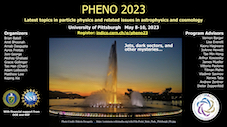Speaker
Description
We constrain a broad class of “hairy” black hole models capable of directly sourcing electromagnetic radiation. We assume this emission is triggered by a catastrophic event, such as a binary black hole merger. This signal is generic and model-independent since it depends only on the black hole mass and the proportion of that mass released as radiation (denoted by $\epsilon$). In the most energetic regime, this mechanism triggers pair- production to produce a gamma-ray burst. Since the Fermi Gamma-ray Space Telescope has not observed a gamma-ray burst from a binary black hole merger, we constrain $\epsilon$ to be $< 10^{−4}$ $(10^{−5})$ for a 10 (30) $M_\odot$ black hole. These constraints will improve as Fermi continues to monitor the sky. In the less energetic regime, ambient charged particles are rapidly accelerated to nearly the speed of light by the strong electromagnetic field. For 1-30 $M_\odot$ black holes and $\epsilon$ ranging from $10^{−20}$ to $10^{−7}$, the typical proton energies were ∼ $20−10^4$ GeV and electron energies were ∼ 0.01−10 GeV. At these energies, cosmic ray protons and electrons quickly diffuse into the Milky Way’s background magnetic field, making it difficult to identify a point source producing them. Overall, constraining $\epsilon$ in this less energetic regime becomes difficult and future constraints may need to consider specific models of “hairy” black holes.

